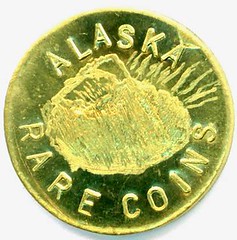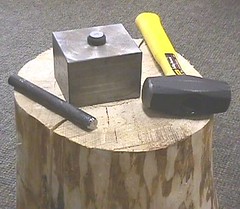
PREV ARTICLE
NEXT ARTICLE
FULL ISSUE
PREV FULL ISSUE
NEW BOOK: STRIKING GOLD IN ALASKA BY DICK HANSCOM
Dick Hanscom of Alaska Rare Coins in Fairbanks has written and published a new book: Striking Gold in Alaska: Making Tokens from Placer Gold.
-Editor
The Press Release reads as follows:
This 60 page book (8 1/4 inches by 5 3/8 inches) is fully illustrated in black and white, with color covers. It follows the process from purchasing the gold, preparing the gold for striking, engraving the dies, and striking. Formulas are given for fluxes, specific gravity, and determining the size of the tokens. Sources of supplies and equipment are listed. The price is $12 postpaid from Alaska Rare Coins, P.O. Box 72832, Fairbanks, AK 99707. From the book's back cover: Rather than do something constructive, Dick Hanscom has been making gold tokens from Alaska placer gold since 2005. Sadly, he has no artistic talent, few metal working skills, and should not be trusted with anything more technologically advanced than a hammer. Fortunately, a 3 pound hammer is all it takes for most of his tokens.


It's a well-illustrated book, with about one black and white photo per page. You couldn't ask for a better how-to guide. It's arranged in three main sections: Making Planchets, Making the Dies, and Striking. An Appendix lists formulas for flux components, measuring specific gravity, and estimating the fineness and dimensions of the gold tokens. Also included are tables of the sizes and characteristics of the gold tokens. Here are some excerpts. It all began in 1990. I was at the ANA convention in Seattle. There was a burly Fijian sitting behind a log, hand striking 1/20 ounce gold tokens. This was the Pacific Sovereign Mint's exhibit promoting a new bullion coin series. The coins were struck from unrefined Fijian gold. The purity was touted as 75% to 84% with a minimum of 75%. This series, while interesting, did not fulfill the requirements of bullion coinage. It lasted three years.
Enter years of procrastination. In 2005, I looked for another die cutter and I remembered Charles Arceneaux. He had struck pewter tokens for my wife's basketball team in 1981. I found Charles and got in touch with him. Sure, we can have the dies done by May 21 (to give a little breathing room for my actual required date of June 21)! And we were well on our way. The upper die was smoothed off and roughly cut. Then, I received an email from Charles with "Panic" in the subject line. The lower die had been hardened and could not be engraved. I have very little knowledge of such things, but seemed to remember something about heating to soften steel. Charles looked into it. He had access to a kiln and was able to anneal the die to soften it. Because of the annealing problem, we missed my June 21 deadline, but darn, we were close. The dies arrived about July 1. Now it was up to me to process the gold and strike the tokens. I use raw, unrefined Alaska placer gold. Estimated fineness is .750 to .850, and some is even higher. To prepare the gold for striking, it must be melted with an oxygen/propane torch in a ceramic crucible. Acetylene is not recommended. Then, it is poured into an ingot mold. After cooling by dropping it into a bucket of water, the ingot is removed and rolled in the rolling mill to a thickness of .65mm. Using a disk cutter to cut a 14mm blank, this thickness gives a weight of just over 1 DWT (1/20 ounce). The mold is shown with gold in the bottom and slag adhering to both sides of the mold on the previous page. Striking is a simple process. The blank is carefully centered on the lower die. A guide (a wooden block with a hole drilled to accept the upper die) is placed over the lower die, and the upper die is carefully inserted in the guide. This guide keeps the dies properly aligned during striking. It also gives me a place to hold onto the upper die while I am hitting it with a three pound hammer. I prefer to keep my hand out of the way! I was soon minting 1 DWT tokens. My first three experimental/presentation pieces were made with unattributed gold.
Dick's a regular E-Sylum contributor. Many thanks for providing the images and text for this article. The book is a great record of the creation of these interesting pieces. It's a shame that over the years more private minters haven't set their stories to paper - how much more we would know about them and their work, which is all too often shrouded in obscurity.
The Numismatic Bibliomania Society is a non-profit organization promoting numismatic literature. See our web site at coinbooks.org. To submit items for publication in The E-Sylum, write to the Editor at this address: whomren@gmail.com To subscribe go to: https://my.binhost.com/lists/listinfo/esylum All Rights Reserved. NBS Home Page Contact the NBS webmaster 
|

